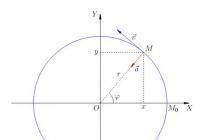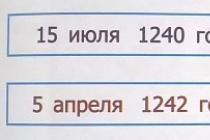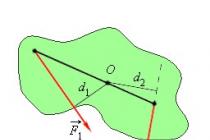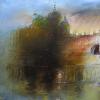Analysis of the poem "The Sea" by V.A. Zhukovsky.
The poem is written tetrameter amphibrachia, the way of rhyming is then a ring, then a cross rhyme. All these rhythmic features help to catch the rhythm of the lapping waves.
The poem refers to romantic direction: one feels dissatisfaction with reality, an impulse for freedom, striving for the ideal. The world of the romantic is a sublime, unusual, extraordinary world. The romantic poet thinks, as a rule, in generalized categories.
History of creation.
V.A. Zhukovsky. In 1820-1821, Zhukovsky took a trip to Germany by sea, which is associated with the poet's personal drama - deep feeling to Maria Protasova and the disagreement of his mother's beloved for marriage. Attempts to achieve agreement were unsuccessful and brought severe disappointments to the lovers. These circumstances colored the poet's intimate lyrics in tragic tones. Maria's marriage in 1817 and then her early death in 1823 became Zhukovsky's personal drama.
At the heart of a lyrical piece is a seascape. The author portrays the sea as beautiful, majestic. It visibly appears before us thanks to pictorial epithets. Psychological, emotional and evaluative epithets prevail- this is how a natural landscape becomes, under the artist's pen, a psychological landscape, a “landscape of the soul” of a lyrical hero. The sea is unpredictable and capricious. This contradiction, inherent in the very nature of the sea element, is emphasized by the antithesis underlying the work. Zhukovsky opposes the calm sea, pouring with "radiant azure", that is, the light of dawn, with the stormy sea, which "tears and torments the hostile mist", which gives the elegies tension and dynamics.
Feature of poetic speech:
1. In Zhukovsky's elegy assonance [oh, y] allows you to feel the depth of the sea, the incomprehensibility of its secrets ("silent sea, azure sea").
2. Inversion, which enhances the semantic meaning of the key words in the verse: "over your abyss", "your secret", "golden clouds", "his stars", etc .;
3. Verbal repetitions, making poetic speech expressive and musical: "silent sea, azure sea", "sweet life" - "sweet shine";
4. Anaphora, which enhances the expressiveness and elevation of the verse. Zhukovsky has a lexical anaphora - the repetition of the same word "you", one line "silent sea, azure sea ..."; syntactic anaphora - repetition of the same syntactic constructions: "You are alive", "You are pure"; "What drives ...", "What breathes ..."; "You are pouring ...", "You are beating ...", "You are tearing ...".
5. Emotional and psychological pauses, marked with dots and dashes, expressing the feelings of the lyric hero. So, for example, Zhukovsky, after a series of questions addressed to the sea, puts an ellipsis, denoting infinity, the insolubility of these questions and the impossibility to fully comprehend the “deep secret” of the “silent sea”.
6. Zhukovsky uses solemn vocabulary, Slavicisms, archaisms, outdated forms of words, giving the works solemnity, majesty: "confused love", "out of earthly bondage", "shining with stars", "clouds are gathering", "you rise waves", "frightened waves ";
Composition of Zhukovsky's poem. This is a kind of lyrical plot that constitutes movement, the development of a state not so much of the lyrical hero or nature that he observes, but of the soul of the sea. But how can the sea element have a soul? Romantics do not doubt this. Indeed, according to their ideas, it is in nature that the Divine dissolves, through communication with nature one can speak with God, penetrate into the mystery of being, and get in touch with the World Soul. That is why in the works of romantics that special lyrical symbolic landscape, which we see in Zhukovsky's poem "The Sea", so often appears. Its peculiar plot can be divided into three parts: "The Silent Sea" - the first part, "The Tempest" - the second part, "Deceiving Peace" - the third part.
In the text there is a roll of natural and human - the state of the lyric hero. It seems that lyric hero speaks with a thinking and feeling interlocutor. Like a person, the sea cannot feel absolute peace and harmony, its freedom is relative. The soul of the sea is like a human soul, where darkness and light, good and evil, joy and sorrow are combined. The poet addresses the sea with questions, as if to a man: “What moves your immense bosom? What does your tense chest breathe? " The sea remains a mystery to him. Reflections lead him to the idea of the similarity between the life of the earth and the life of the sea. The sea from "earthly bondage" stretches to the sky in order to find the desired freedom.
The poem conveys incredible emotions and feelings that the writer wanted to show us, I believe that he did it. "The Sea" is a powerful piece, and I really liked this poem.
"The Sea" by V. Zhukovsky is written in the spirit of romanticism. The poem shows how subtly the poet felt the powerful element. At school it is studied in the 9th grade. We invite you to familiarize yourself with brief analysis"Sea" according to plan. He will be an excellent assistant in preparing for lessons and EGE.
Brief analysis
History of creation- was written in 1822, when V. Zhukovsky had already formed as a poet and was known in literary circles.
Poem theme- the beauty and character of the sea.
Composition- The work is conditionally divided into semantic parts: a description of a calm sea and a landscape that reproduces the raging sea expanses. Formally, the poem is not divided into stanzas.
genre- elegy.
Poetic size- tricycle amphibrachium, lines do not rhyme.
Metaphors – “You're alive; you breathe confused love, you are filled with anxious thought ”,“ what moves your immense bosom ”,“ you fight, you howl, you lift waves ”,“ you, admiring the sky, tremble for it ”.
Epithets – "Silent sea, azure sea", "earthly bondage", "distant, bright sky", "mysterious, sweet" life, "Radiant azure", "dark clouds".
History of creation
The analyzed poem V. Zhukovsky wrote in 1822. The mature period of the poet's work was marked by the transition from sentimentalism to romanticism. This trend was very popular in Russian literature at the beginning of the 19th century. We can see its signs in The Sea, which researchers consider the poet's programmatic work.
The history of the creation of the poem is associated with the personal experiences of the author. At the time of the appearance of the literary sea landscape, he was in love with Maria Protasova, but he could not start a family with her. Maria's mother was the poet's cousin.
Theme
In the work, the author develops the theme of the beauty and power of the sea element. The main characters of the lines are the lyrical hero and the sea. To show all the facets of the elements, V. Zhukovsky creates static and dynamic landscapes in one piece.
Under the image of the lyrical hero, there is a mature man who knows how to understand nature, and speaks with the sea as with an old friend. Being alone with the sea brings him pleasure: "I stand enchanted over your abyss."
In the first part of the poem, the sea is silent. The azure of the sea pleases the lyrical hero's eye. The man is sure that the sea is alive, and he also knows that the expanses of water are fraught with a disturbing thought. The lyrical hero asks the sea to reveal its secrets, hidden deep in the bosom. He guesses that the sea element is reaching for the sky. It merges with the "radiant azure" of the sky, is filled with its light.
The union of sea and sky is destroyed by black clouds. They are trying to take away the height, but the water element does not give it up without a fight. The sea beats, howls, seethes with waves and breaks the mist. Soon it wins the victory, but it worries for a long time, heated up by the battle. To reproduce the raging sea, the author string together verbs. They add dynamism to the landscape.
In the last verses, the lyric hero tells how the sea admires the sky motionlessly, but inside it worries about it. Apparently, this "character trait" of the sea is what the hero likes.
It can be assumed that by means of metaphorical images V. Zhukovsky spoke about his relationship with M. Protasova. The sea is the embodiment of the author himself, and the sky symbolizes his beloved.
Composition
In the 9th grade, it is important to be able to analyze the semantic and formal organization of works. According to the meaning, "Sea" can be divided into two parts: a description of a calm sea and a landscape that reproduces the raging sea expanses. The poem is not divided into stanzas. Due to the peculiarities of the composition, the lines resemble waves in the endless sea.
genre
V. Zhukovsky himself defined the poem as an elegy. Indeed, it was written in this genre, because the work is of a contemplative nature, and sad notes appear in its lines. The poetic size is a three-foot amphibrach. The lines are not united by rhymes, their consonance is based on the rhythm.
Expression tools
To convey the inner state of the lyric hero and reproduce beauty sea spaces V. Zhukovsky used artistic means. The main role in the text is played by metaphors: “You're alive; you breathe confused love, you are filled with anxious thought ”,“ what moves your immense bosom ”,“ you fight, you howl, you lift waves ”,“ you, admiring the sky, tremble for it ”. Epithets give expressiveness to marine paintings: "silent sea, azure sea", "earthly bondage", "distant, bright sky", "mysterious, sweet" life, "radiant azure", "dark clouds".
Poem test
Analysis rating
Average rating: 4.5. Total ratings received: 139.
You can analyze poems different ways... Some teachers require students to express their own position and reflect. For others, it is more important to search for various artistic and expressive techniques in the text. Therefore, the plans of different teachers look differently. We suggest that you familiarize yourself with the general approaches to the analysis of Zhukovsky's "Sea".
Plan
In order for the analysis of a poetic text to be complete, you should adhere to a certain plan. Often teachers themselves dictate to the students the sequence of points, but if this did not happen, it is recommended to adhere to this plan:
- General information about the poem: date of creation, history and Interesting Facts writing, place in creative way the author. When disclosing this paragraph, you must be brief.
- Main theme. What is the text about, what is the meaning of its name. The main ideas of the work, the thoughts of the author.
- Description of the lyric plot. It is not necessary to completely retell in prose what the writer has outlined in verse, it is enough to outline the points that are important for analysis.
- Features of the composition. How the construction of the text works to reveal the author's intention: perhaps there is a circular composition, opposition, comparison of one phenomenon with another.
- Lyrical hero. What poetic techniques the author uses to reveal his image.
- Other characters, their place and role in the overall design.
- Author's position. Disclosing this point, you should not strive to "answer correctly", it is much more interesting to express your own judgments.
- Rhyme, size, rhythm. It is important to be able to use your knowledge of literary terms here.
- Features of poetic vocabulary and syntax. The techniques of artistic expression used by the poet.
- The perception of the poem by the author's contemporaries in our days.
We will adhere to this plan when analyzing the elegy "The Sea" by Zhukovsky - one of the most famous texts of the poet.
General information about the poem
Zhukovsky is a romantic poet, it was he who was considered his main teacher by Pushkin. The work of this author became the most important stage in the development of romanticism as a literary trend, personal experiences were reflected in his lyrics, intimacy appeared, and the main character was a person - a feeling, experiencing.

Among the masterpieces is the elegy "The Sea", created in 1822. It is interesting that the very image of the endless sea was new for Zhukovsky's work, but it was he who summed up the poet's romantic quest. Literary critics believe that the text is dedicated to the poet's beloved, Maria Protasova, for whom the feelings were deep and mutual, but reality severely invaded romance - Maria's parents were against such an unequal marriage, and the girl did not dare to go against them.
It is known that the elegy was highly appreciated by Pushkin, who a few years later wrote his own poetic text with a similar title.
Main theme and idea
According to the plan, the analysis of Zhukovsky's "Sea" should be continued by defining the theme of the poem. So, if you read the lines, it becomes clear that it is dedicated to the azure sea. It is silent, but it thinks an anxious thought.
Zhukovsky himself is present in the text - the poet presented himself in the image of the sky, which creates a harmonious sensual union with the sea, but will never be able to unite with it.

Lyrical plot
When analyzing Zhukovsky's elegy "The Sea", it is very important to outline the main stages in the development of the lyrical plot. First, the poet draws in front of his readers an ordinary sea, silent and azure, which the lyrical hero admires. Gradually, the element acquires the features of a living being: breathes, filled with "anxious thought", "troubled love."
Further, the image of the sky appears, another beautiful and free element, to which the sea stretches. Then the poet figuratively and vividly draws the separation, from which the sea tears and torments the "hostile darkness." But alas, parting is inevitable, and you have to put up with it. However, feelings cannot be ordered, which is why sad notes are especially strong at the end of the text.

Zhukovsky writes that he refuses to fight for happiness, as the sky can never reach the sea surface.
The specifics of the composition
The next stage in the analysis of V. Zhukovsky's poem "The Sea" is the description of its composition. To do this, you should carefully re-read the text again, highlighting the parts in it. It is immediately striking that the sea in front of us is drawn in its three states:
- Calmness of the sea surface. Silent sea.
- Condition in a storm.
- After the storm. Deceptive peace.
The lyrical hero carefully monitors all the changes that occur with the elements, it is these changes that drive the development of the plot. When analyzing Zhukovsky's "Sea", it is important to show why such a composition is used. Due to her, the poet manages to create a dynamism of the image, so the sea has a changing character.
- So, the first part of the elegy is a sketch of a calm and beautiful sea, which does not excite passion. The sky in this fragment is also clear and beautiful.
- The second structural part is the state of the sea at the moment when the clouds cover the sky with their black veil, a storm begins. And the sea responds to it, begins to "beat" and "tear", is filled with anxiety and fear. The elements are threatening at this moment, but not everyone realizes that the sea is suffering. The mystery becomes clear - the omnipotent element, like all living things, cannot fully control its fate, it is in captivity of circumstances.
- Finally, the third part - the sky is calm again and the sea, it seems, too, but this is only an appearance. In his soul, carefully hidden passions are still raging.
Such a composition is aimed at the embodiment of the author's intention - to show that even the elements cannot be completely free.

Lyrical hero
In the analysis of Zhukovsky's "Sea" it is very important to reveal the main features of the lyrical hero. He subtly captures all the shades of the mood of the magnificent element and guesses that passions are raging under his apparent calmness.
The lyrical hero not only admires the elements, but also humanizes it: the sea seems to be a living creature that hides a whole range of feelings behind its deceptive smooth surface. That is why the motives of comparing the sea with a woman in love, who protects the secrets of her heart from strangers, sound. Some researchers believe that in the image of the elements, the poet embodied the features of his lost lover, Maria Protasova.
Author's position
Zhukovsky is a romantic poet, therefore, in his elegy, the latter wins in the struggle between the darkness and the sea. But the poet shows that not everything is so simple, passions continue to rage in the depths of the waters, when the surface is calm and smooth.

Rhythm and rhyme
The next stage is the analysis of Zhukovsky's elegy poem "The Sea" according to plan - the identification of the features of rhyme and rhythm. To create a special sound, the poet uses white verse - some lines do not rhyme with each other. The size of the verse is four-foot amphibrach. In order to paint a vivid picture of the storm in front of the reader, in the second part the poet skillfully uses alliteration - the repetition of identical consonant sounds in standing next to words. This enhances the sensation of oncoming waves.
Artistic techniques, syntax and vocabulary
The genre of Zhukovsky's "Sea", which we are analyzing, is elegy. It is a sad poetic genre, often filled with longing, grief and disappointment. It was he who was inherent in romanticism as a literary movement, and in the lyrics of V. Zhukovsky. The text found expression of the poet's deeply personal experiences, which helped the author to use following techniques artistic expressiveness:
- Epithets are the main technique, there are quite a few of them in a small text: "azure sea", "silent sea", "deep secret", "hostile haze". They help the author to concisely and figuratively show the state of the elements.
- The refrain - "silent sea, azure sea" - helps the author to emphasize the main idea of the text, to show that the element is dual, that its true state is hidden.
- Anaphora - "you" - creates the rhythm and melody of the verse.
- Using syntactic repetition.
These techniques helped the poet to create a deep psychological landscape; in a small text, both the beautiful sea element and the subtlest shades of the experience of the human soul were reflected.

Output
We analyzed Zhukovsky's elegy "The Sea" according to the plan, now it is necessary to describe the meaning of this poetic text. For the poet's contemporaries, the poem became a kind of anthem of romanticism, so many poets subsequently turned to the image of the majestic element. It has not lost its significance in our days.
Reading and analyzing the verse "The Sea" by Zhukovsky allows you to plunge into the inner world of the poet and understand his thoughts and feelings.
Elegy by V. Zhukovsky "Sea". Analysis.
"The Sea" is one of the beautiful elegies written by Zhukovsky in moments of meditation. The poet paints the sea in a calm state, in a storm and after it.
In his address to the sea at the beginning of the poem, the poet uses many vivid epithets, but only one of them characterizes the sea as a wonderful natural phenomenon - "azure". This is an outdated and lofty word for light blue. All other pictorial means give the sea a resemblance to a living, thinking, feeling creature: "silent" ("you are alive" ("you breathe", "you are filled with confused love, anxious thought." the poet's imagination is occupied by him, and the sea appears to him as a living, thinking creature, because he is worried and disturbed by something in his own soul.
“I am standing enchanted over your abyss” - the lyrical hero seems to be looking at the sea from above, from some high sheer cliff. The sea is immense and bottomless, it beckons to itself, attracts with its "deep secret". The movement of the sea and its various states are conveyed by numerous verbs - metaphors and personifications: "you breathe", "moves"; “Caress”, “burn”, “shine”, “beat”, “whine”, “lift”, “tear”, “torment”, “lift”, “hide”, “tremble”. Zhukovsky endows the sea with tremendous strength, the ability to fight and tenderness, the ability to love.
As the mystery of the sea is solved, the views of the romantic poet are revealed: the sea is in earthly captivity, like all living things. Earthly life is full of strife, loss, disappointment. Only there, in heaven, everything is beautiful and unchanging. Even the clouds, seemingly belonging to the sky, exist in Zhukovsky by themselves. They only gather to "take away" the sky, while it itself is "distant", "bright", "clear", "clean". It is beautiful and defenseless. The contrast between "dark clouds" and "clear" skies underlines this. The struggle of the sea against dark, hostile forces symbolizes the struggle of man against evil. Last picture- the sea after the storm - shows the psychological skill of the romantic Zhukovsky. The onset of calm is only apparent, external:
Deceiving your immobility the view:
You hide confusion in a calm abyss.
Admiring the sky, you tremble for it.
Lermontov's Sail involuntarily comes to mind:
And he, rebellious, asks for the storm,
As if there is peace in the storms!
The sea at Zhukovsky and the sail at Lermontov are romantic heroes. They cannot exist without a struggle. True, Lermontov's ideal is the struggle itself, while Zhukovsky's is something high and pure - "heaven." This ideal is unattainable, but does this mean that there is no need to fight for it?
There is a special value system in the elegy genre. The eternity of limitless existence presupposes a pantheistic mystery, against the background of which life acquires personal integrity due to its ultimate concentration in time and space. Elegiac beauty is the “farewell beauty” of an irrevocable moment, and elegiac experience is a feeling of living sadness about the disappeared.
The elegy "Sea" was written by V. A. Zhukovsky in 1822. This poem expresses the sad reflections of the lyrical hero over the mysterious and amazingly picturesque element of water. A "deep secret" is kept in the abyss of the azure sea. It is she who attracts the lyric hero both with her dramatic tension, and with her serenity, immobility. The poet is concerned about the relationship between the two abysses - sea and heaven. The sea at Zhukovsky is not free, in contrast to the absolutely free sky. The sea languishes in "earthly captivity", it can only enjoy the sight of the "distant", "bright" sky. It seems that two beings, feeling their kinship, spiritually gravitate towards each other. Love for the sky is a lofty ideal that fills the life of the sea with deep meaning. At the same time, sea, sky and storm are symbolic images... Zhukovsky's sky is a symbol of serenity, peace, beauty. When the sea conquers hostile clouds, the "sweet brilliance of the returned heavens", silence, stillness triumphs. But the sky also symbolizes the soul flying upward - the desire for unearthly perfection. In turn, the sea is also a symbol of the changeable human soul.
In the poem, only the image of the sea changes and develops. Through the eyes of the lyrical hero, we observe his movement from a height. Zhukovsky surprisingly accurately chose the style of the poem: the elegy is a poetic appeal of the lyrical hero to the sea element. Perhaps she reminds him of his own state of mind:
I stand enchanted over your abyss.
You are alive; you breathe; troubled love
You are filled with anxious thought ...
The movement of the sea is similar to the irreversibility of human life. Therefore, through the prism of the central image of the elegy, the lyric hero speaks of his own experiences and feelings.
An important feature of the poem is the connection between statics and dynamics. The colorful descriptions that Zhukovsky draws are combined in an elegy with elements of the narrative: the lyrical subject talks about the sea as a living being that loves, thinks, fights against dark clouds for the sky:
When dark clouds gather
To take the clear sky away from you -
You beat, you howl, you lift the waves,
You tear and torment the hostile mist ...
It is important to note that the conflict between the sea and the forces opposing it is resolved by the end of the poem. However, the image of the sea does not reach complete inner harmony and external serenity:
And the haze disappears and the clouds go away;
But, full of his past anxiety,
You heave frightened waves for a long time,
And the sweet splendor of the returned skies
Silence does not return you at all ...
The lyrical hero feels the deceitfulness of the still sea. It is no coincidence that the last lines of the poem reveal the main idea of the elegy:
You hide confusion in the abyss of the deceased,
Admiring the sky, you tremble for it.
True life consists in eternal movement, in eternal struggle. One gets the impression that the lyric hero sees happiness and joy in the battle for love. You cannot calm down, you cannot resign yourself. Victory over the "dark clouds" of life can only be won in an intense struggle. The apparent silence and inner drama of the sea reflect the state of mind of the lyric hero.
V this poem reveals the romantic theme of the eternal yearning for the ideal, the restless pursuit of a distant dream:
Silent sea, azure sea
Tell me your deep secret:
What drives your immense bosom?
What does your tense chest breathe?
Or pulls you out of earthly bondage
Distant, bright sky to yourself? ..
In order to show the constant movement of the sea as vividly as possible, Zhukovsky uses many verbs. In almost every line of the poem, the lyrical hero describes the changes of the sea: the sea breathes, filled with "swept away love" and "anxious thought." From the very beginning of the elegy, Zhukovsky lets us know that the sea has a soul. Spirit, according to Zhukovsky, is the basis of life. The dynamics of the development of the image of the sea takes place in opposition to the static sky. The lyrical hero describes the brilliance of the heavens in warm and light colors. The abundance of epithets helps the poet to enhance the contrast between light and darkness. In the disclosure of the relationship between the two elements, an antithesis is used. The nouns "love", "life", "light", "silence" are opposed to others: "mystery", "bondage", "clouds", "anxiety", "confusion".
Slavicisms and archaisms sound in a special way in the romantic context, giving the elegies the color of a high poetic style. Repetitions enhance the melody and musicality of the piece.
The elegy "Sea" can be divided into two semantic parts. The first part (the beginning of the elegy) is a lyrical appeal to the sea element. We learn that the "silent sea" is filled with anxious thought. In the second part, the poet reveals a "deep secret" to the reader. It is important to note that, despite the large volume, the poem is harmonious and proportional. These qualities are given to the verse by rhyme and rhythm. The elegy was written by a tetrameter amphibrachium. The neutrality of this size is combined with an undeniable melodiousness, so the lack of rhyme is not noticed. The elegy sounds like the movement and noise of a wave, the ebb and flow of the sea is felt. If at the beginning it is silent and calm, then the "free element" is more and more worried. When the sky is covered by clouds, the sea, fearing separation from it, "torments the hostile darkness." The poet uses such a syntactic device as gradation: "You fight, you howl, you rise waves, // You tear and torment the hostile darkness ..." This is the culmination of the elegy. Then the sea calms down, but the lyrical hero says that this serenity is deceiving.
The elegy "The Sea" is rightfully considered to be Zhukovsky's manifesto as a romantic. The main thing in it is the image of a person's feelings, his emotions and experiences. An appeal to landscape lyrics, more precisely to the sea element, is necessary for the poet in order to understand more deeply and vividly the changes in the human soul. The sea is personified in the poem. At the same time, it is a symbol of longing and lack of freedom. The sea element is associated with the abyss of the human "I".














